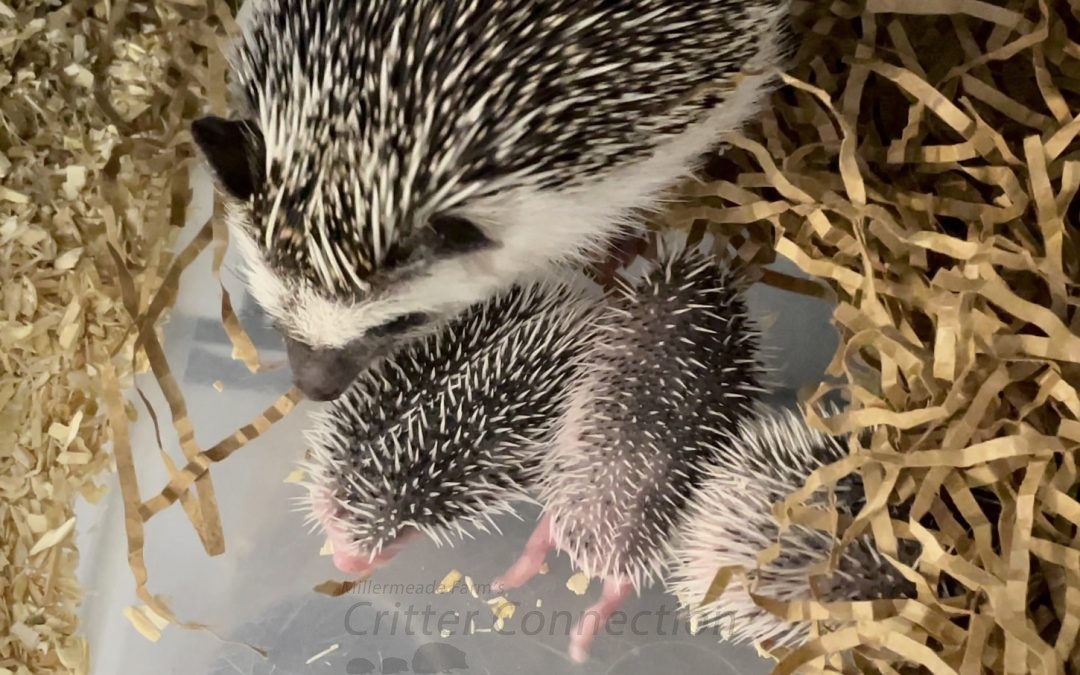Last Updated on August 31, 2022.
VIDEO of our background and start with hedgehog breeding stock, as well as an introduction to pedigrees and the creation of Hedgie List
Life Expectancy
We do our very, very best to produce happy hedgehogs that exceed the average life expectancy. Most breeders and enthusiasts agree that the average pet life expectancy is approximately three years. When hedgehogs were first introduced into the pet industry hedgehogs were reported to live 8-10 years. Hedgehog owners, breeders, and enthusiasts all would love to determine what has caused an overall drastic decrease in pet longevity and how to ensure that each hedgehog lives to its full life expectancy potential.
Factors Involved in Longevity
- Breeding and Genetics – please refer to our plan for more information on this topic.
- Diet – at the time of this writing no long-term scientific studies have been published related to hedgehog nutrition research. Recommendations from owners, breeders, enthusiasts and experts vary widely with little scientific evidence to the nutritional hypothesis for the best captive-bred hedgehog diet.
- Water – this is especially important with babies but water consumption can greatly impact overall animal’s health.
- Temperature – it has been our experience that hedgehogs can survive at cooler temperatures but are more prone to problems. Hedgehogs seem to thrive at 75 °F to 80 °F.
- Bedding- some bedding can cause impaction if eaten and respiratory stress due to phenols.
- Exercise – lack of exercise can lead to obesity but excessive exercise can also lead to increase in metabolism and excess free radical formation/damage.
- Freak accidents or illnesses.
- Promptness and quality of veterinary care.
- Level of stress and quality of life.
- Breeding and reproduction complications.
Our Herd Males
A large majority of our males come from breeders across the country. We carefully select fellow breeders who have an excellent reputation and who can provide us with information about their breeding practices, herd health, and pedigrees.
We do occasionally retain males from within our herd that exhibit physical traits or genetic lines that are particularly useful for future breeding. For example, if we have a male that consistently produces exceptionally large litters and vigorous babies we are likely to keep one of his sons. Many hedgehog lines from other breeders are simply lost because breeders stop breeding or particular lines were dispersed to pet homes and few remain in breeding programs. If we are aware that a particular line is in danger of being lost we will often retain a baby to preserve that breeding line.
We have used males in our herd either from small private breeders whose breeding stock was obtained from other small private breeders who did not maintain detailed pedigrees. On occasion we have used animals that have no known linage but are in excellent health/physical condition and offer a color or feature previously unavailable.
Most males are used in our breeding program until they are approximately 18 months of age and are then retired to pet homes. We believe that a new supply of bloodlines through our males ensures optimal genetic diversity in our herd.
Our Herd Females
Our herd-management program is based on principles that we have learned and tested through experience raising other animals since my earliest memories as a child. My experience breeding and showing commercial rabbits instilled in me the value of retaining future breeding females from current litters. By selecting breeding stock from within the current herd it is possible to closely monitor litter growth and development as well as breeding line productivity. We have been breeding and selling hedgehogs since the summer of 1997. Many of the females in our herd can be traced back 10 to 20 generations back to our original animals. We select future breeding females from large litters that grow on target and that have no known health complications.
Breeding Compatibility
Due to the fact that we retain females from our herd and procure a significant number of new herd males from other breeders we are able to ensure a wide genetic diversity in our herd. Each of our breeding females has a breeding record where we record her parents, date of birth, weight record, diet changes, breeding dates, and litter information. Females are matched with males to ensure they are directly unrelated. It is possible that hedgehogs may have some common answers and each potential mating can be evaluated in our pedigree breeding system to obtain an inbreeding coefficient.
Each baby is identified using a color-coding system that allows us to keep track of the parents and subsequent lineage of each animal.
VIDEO.: Producing happy healthy hedgehogs
- [GD1] At the time of this writing I cannot find the article that described the results of this study.
Contributors: Gail Smith, Melissa Ramos






